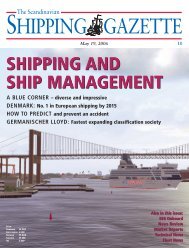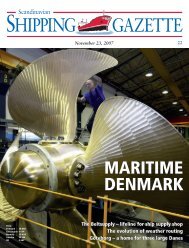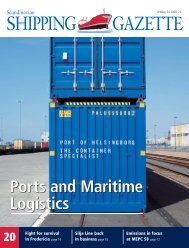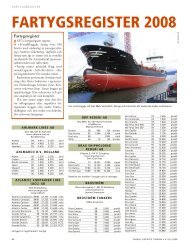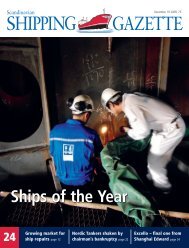SSG No 20 - Shipgaz
SSG No 20 - Shipgaz
SSG No 20 - Shipgaz
Create successful ePaper yourself
Turn your PDF publications into a flip-book with our unique Google optimized e-Paper software.
PORTS & MARITIME LOGISTICS<br />
The entrance of the port in Kolobrzeg has been broadened.<br />
the port of Gdynia, which this year celebrates<br />
its 85th anniversary, will increase<br />
capacity in Gdynia alone to an estimated<br />
one million TEU a year.<br />
Also in Swinoujscie container turnover<br />
grows at a faster pace. VGN Terminal is<br />
called by container ships twice a week. The<br />
terminal has signed a contract with Icelandic<br />
Samskip that operates a service between<br />
Swinoujscie and Hull in England (45-feet<br />
containers) and poses a real threat to roadhauled<br />
trailer transports.<br />
Szczecin is also experiencing growth. So<br />
far containers have been handled mainly at<br />
the Czeskie quay but a new container terminal<br />
is being built on Ostrow Grabowski.<br />
The terminal is to be completed by the<br />
beginning of <strong>20</strong>08. Capacity is planned to<br />
reach 80,0000 TEU and further expansion<br />
will be possible.<br />
Become the leading container hub<br />
The ambition of the Port of Gdansk is<br />
to become the leading hub for container<br />
transshipments in the Baltic Sea region.<br />
In the Inner Port, situated at the Martwa<br />
Wisla, there is a smaller and well managed<br />
terminal, the Gdanski Terminal Kontenerowy<br />
(GTC). Handling is now restricted by<br />
lack of storage facilities, making it impossible<br />
to handle many containers at the same<br />
time. This may change when planned road<br />
investments have been completed. GTC<br />
has received a new efficient gantry crane<br />
(40 t), which will definitely increase efficiency<br />
in the terminal.<br />
The huge terminal site of Deep Water<br />
Terminal Gdansk, in Port Polnocny (<strong>No</strong>rthern<br />
Harbour), is completed, and the largest<br />
container ships in Baltic Sea trades will<br />
be able to call the terminal. A test call has<br />
been made by the 822-TEU Gotland of<br />
Football supporters seem<br />
to be far more convincing<br />
to Warsaw than the<br />
basic need of acceptable<br />
infrastructure for economic<br />
development.<br />
Team Lines, discharging 53 Hapaq-Loyd<br />
containers, and the terminal will by fully<br />
operational at the end of October <strong>20</strong>07.<br />
Capacity will be 500,000 TEU annually.<br />
Marek Czerkowski of Deep Water Terminal<br />
Gdansk predicts that the terminal will<br />
handle at least <strong>20</strong>,000 TEU during the rest<br />
of this year.<br />
Since the end of September <strong>20</strong>07, DCT<br />
Gdansk operates three ship-to-shore (STS)<br />
post-panamax gantry cranes and five RTGs.<br />
The next stage of DCT is to increase capacity<br />
at the deepwater terminal to at least one<br />
million TEUs a year.<br />
In the close neighbourhood of DCT, a<br />
210-hectare logistics centre is developed.<br />
So far, only Team Lines and CMA CGM<br />
have openly expressed interest in the terminal.<br />
However, it is more than sure that<br />
the experienced team of English managers<br />
including Collin Chanter and Robin<br />
Macleod does not reveal all its plans.<br />
There is yet another question to deal<br />
with, and that is to connect the terminal<br />
and the entire port with the new A1 motorway.<br />
This is vital, but today there are some<br />
delays at the so-called Trasa Sucharskiego.<br />
The container terminals in Gdynia have<br />
the same problem. The increased container<br />
turnover means that development of the<br />
LESZEK SZyMANSKI<br />
road infrastructure is absolutely necessary.<br />
According to a report from the Supreme<br />
Chamber of Control, the ports of Gdansk<br />
and Gdynia lose USD 250 million a year<br />
because of the lack of the A1 motorway<br />
connection. Forwarders from southern<br />
Poland, Slovakia and The Czech Republic<br />
prefer the longer but much better German<br />
motorways and the ports of Hamburg,<br />
Bremerhaven or Rotterdam before the narrow<br />
and dangerous National Road <strong>No</strong>1,<br />
which is the only way to get from Gdansk<br />
to southern Poland.<br />
motorway ready by <strong>20</strong>10<br />
In <strong>20</strong>05 work on the long awaited A1 was<br />
finally started. The first phase is a 90-kilometre<br />
road from Gdansk to Grudziadz.<br />
The next phase, Grudziadz–Torun, is to be<br />
started in the spring next year. The Polish<br />
government has promised that the entire<br />
motorway will be ready by the end of <strong>20</strong>10.<br />
Thanks to funds provided by EU in<br />
<strong>20</strong>06, construction of a connection with<br />
the port of Gdynia has begun. The 3.5 kilometre<br />
long road, which Gdynia has awaited<br />
for nearly 30 years, will connect the already<br />
existing ring way with Estakada Kwiatkowskiego,<br />
a two-lane road that leads to the port,<br />
shipyard and the navy base.<br />
The total investment is PLN 240 million<br />
(EUR 64 million). PLN 180 million (EUR<br />
48 million) comes from EU funds, and the<br />
rest is covered by city of Gdynia. If everything<br />
goes according to plan, the road will<br />
be completed before <strong>20</strong>08.<br />
In Gdansk, Trasa Sucharskiego road will<br />
connect the port with A1. The project<br />
includes construction of an 800 metres<br />
long road tunnel under the port channel,<br />
the first such tunnel in Poland. The cost<br />
for the project, including the tunnel, splitlevel<br />
crossings and an eight kilometres long<br />
road, is estimated to PLN 1,2 billion (EUR<br />
322 million), two thirds of the sum to be<br />
financed by EU and the city of Gdansk.<br />
Some say that the main reason behind<br />
the projects, finally giving the ports good<br />
road and railway connections with their<br />
hinterland, is the European Football Cup<br />
that will be held in Poland and Ukraine in<br />
<strong>20</strong>12. Football supporters demanding new<br />
roads seem to be far more convincing to<br />
Warsaw than the basic need of acceptable<br />
infrastructure for economic development.<br />
After all, the poor road and railway infrastructure<br />
is a result of the fact that this field<br />
has been neglected for many years.<br />
leszek szymanski<br />
64 SCANDINAVIAN SHIPPING GAZETTE • OCTOBER 26, <strong>20</strong>07




